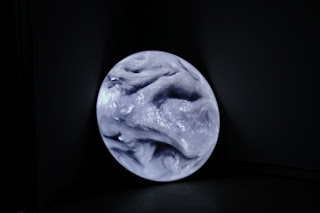Janine Randerson's Albedo of Clouds at Screen Space is a work that evokes the nature of subjectivity. There are two round screens in the space, one up in a high corner at the back of the space and one down low at the front. On these round, planet-looking, screens we see images of clouds projected. We see the human perspectives of experiencing them from the ground and from satellites recording them from space. As we turn our heads to watch the two screens showing clouds we also hear a conversation between two cloud watchers. Each voice is played out of speakers on different sides of the room, which gives a sense that the cloud watchers are in different locations but are trying to see if they can see the same clouds. This gives a sense of following this conversation while being in the privileged position of being able to see both perspectives. The talking is often followed by reverberating sounds that create a soft tension.
The cloud watchers describe the clouds as things they might look like. One looks like a map of North America, a submarine, "Can you see the head?", one asks. The viewer also sinks into the cloud gazing activity—I can see North America once it has been said but I initially thought it looked like a camel. In some cases they just can't see the same thing. When one describes a cloud as looking like a submarine, the other can't seem to see it. They wonder if it is the interpretation they can't see or if they are just not looking at the same clouds. The clouds on each screen look very different. This opens up an interesting idea about whether what we see or understand of the world is experienced in the same way by other people. We can never know if others see and feel the same way as we do.
The cloud, like the Rorschach inkblot, has been used as a way of mapping responses to find out about the psychological preoccupations and motivations of individuals. We can only interpret the abstract shapes of the clouds through a language of associations. Associations that we draw on when we meet a shape again. In art we are presented by an artist with a series of forms or objects. While these objects may have distinct associations particular to the experience of the artist, the viewer will always bring in their subjective projections.
In E. H. Gombrich's chapter The Image in the Clouds he argues for art that exercises the public's imagination rather than just a polished depiction of reality. He says: 'it is an art in which the painter's skill in suggesting must be matched by the public's skill in taking hints'. Randerson's work suggests that the public are very adept in using their imagination to make abstract shapes into forms that communicate. The viewer brings their knowledge, associations and history to make a work understandable. This game of representation has been practised on clouds, rock faces, constellations and birthmarks throughout history. The interesting part of the game in discussing art is, of course, the variety of interpretations. Viewers search through their personal references to understand the abstract ideas that artists have found a way to visualise.
Randerson also presents images of clouds from the view of satellites. The contrast between the perspective of the people on the ground and the satellites seems to initially compare the subjectivity of the cloud watchers with the objectivity of a recording machine. However, in the tense hum of the audio, we continue to turn our head from screen to screen. This motion evokes the sense that this data will too be analysed, categorised and interpreted by people who will again bring their knowledge, their history and their projections to the forms and shapes they see. Randerson's work offers an interesting reflection on how we imagine, learn and interpret the world around us.





No comments:
Post a Comment